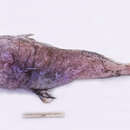en
names in breadcrumbs


The blobfish was discovered in 2012 in a oceanic census that discovered 6,000 new marine species. There is a lot we do not know about the blobfish such as:
1. How exactly does it reproduce?
2. Does it have any social structure?
3. How does it feed itself?
This is not surprising considering that the blobfish was discovered in 2012, only 2y ago.
Psychrolutes marcidus, the smooth-head blobfish,[1] also known simply as blobfish,[1] is a deep-sea fish of the family Psychrolutidae. It inhabits the deep waters off the coasts of mainland Australia and Tasmania, as well as the waters of New Zealand.[2]
Blobfish are typically shorter than 30 cm (12 in). They live at depths between 600 and 1,200 m (2,000 and 3,900 ft), where the pressure is 60 to 120 times greater than that at sea level, which would likely make gas bladders inefficient for maintaining buoyancy.[2] Instead, the flesh of the blobfish is primarily a gelatinous mass with a density slightly less than that of water; this allows the fish to float above the sea floor without expending energy on swimming. The blobfish has a relative lack of muscle, but this is not a disadvantage, as its main food source is edible matter that floats in front of it, such as deep-ocean crustaceans.[3]
Blobfish are often caught as bycatch in bottom trawling nets. It was first discovered around the Norfolk and Lord Howe islands, which are located between Australia and New Zealand. The discovery was made by a team of two dozen scientist during their exploration of submarine habitats. The team towed gear on the ocean floor in order to net and study different species. Among the new species the caught was Psychrolutes marcidus.[4]
The popular impression of the blobfish as bulbous and gelatinous is partially an artifact of the decompression damage done to specimens when they are brought to the surface from the extreme depths in which they live.[5] In their natural environment, blobfish appear more typical for their superclass Osteichthyes (bony fish).

Psychrolutes marcidus, the smooth-head blobfish, also known simply as blobfish, is a deep-sea fish of the family Psychrolutidae. It inhabits the deep waters off the coasts of mainland Australia and Tasmania, as well as the waters of New Zealand.
Blobfish are typically shorter than 30 cm (12 in). They live at depths between 600 and 1,200 m (2,000 and 3,900 ft), where the pressure is 60 to 120 times greater than that at sea level, which would likely make gas bladders inefficient for maintaining buoyancy. Instead, the flesh of the blobfish is primarily a gelatinous mass with a density slightly less than that of water; this allows the fish to float above the sea floor without expending energy on swimming. The blobfish has a relative lack of muscle, but this is not a disadvantage, as its main food source is edible matter that floats in front of it, such as deep-ocean crustaceans.
Blobfish are often caught as bycatch in bottom trawling nets. It was first discovered around the Norfolk and Lord Howe islands, which are located between Australia and New Zealand. The discovery was made by a team of two dozen scientist during their exploration of submarine habitats. The team towed gear on the ocean floor in order to net and study different species. Among the new species the caught was Psychrolutes marcidus.
The popular impression of the blobfish as bulbous and gelatinous is partially an artifact of the decompression damage done to specimens when they are brought to the surface from the extreme depths in which they live. In their natural environment, blobfish appear more typical for their superclass Osteichthyes (bony fish).
 Artist's representation of two blobfish in situ
Artist's representation of two blobfish in situ